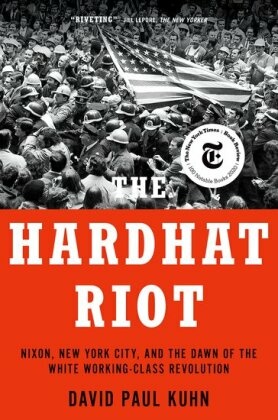The Hardhat Riot - Nixon, New York City, and the Dawn of the White Working-Class Revolution
| Verlag | Oxford University Press |
| Auflage | 2022 |
| Seiten | 416 |
| Format | 15,8 x 2,1 x 23,4 cm |
| Print PDF | |
| Gewicht | 596 g |
| Artikeltyp | Englisches Buch |
| EAN | 9780197577837 |
| Bestell-Nr | 19757783EA |
In downtown Manhattan, in the shadow of the half-built Twin Towers, hardhats beat scores of hippies bloody in May 1970, four days after Kent State. This is the story of when the old Democratic Party attacked the new and of how Richard Nixon seized the breach, realizing that "these, quite candidly, are our people now." We relive the schism that tore liberalism apart by returning to when it was all laid bare one brutal day, when the Democrats' future was bludgeoned by its past, as if it was a violent last gasp to say, we once mattered to them too.
The nail-biting story of when the hardhats of downtown Manhattan beat scores of hippies bloody in May 1970, four days after Kent State, and how the nation reacted.
In May 1970, four days after Kent State, construction workers chased students through downtown Manhattan, beating scores of protestors bloody. As hardhats clashed with hippies, it soon became clear that something larger was happening; Democrats were at war with themselves. In The Hardhat Riot, David Paul Kuhn tells the fateful story-how chaotic it was, when it began, when the white working class first turned against liberalism, when Richard Nixon seized the breach, and America was forever changed. It was unthinkable one generation before: FDR's "forgotten man" siding with the party of Big Business and, ultimately, paving the way for presidencies from Ronald Reagan to Donald Trump.
In the shadow of the half-built Twin Towers, on the same day the Knicks rallied against the odds and won their first championsh ip, we relive the schism that tore liberalism apart. We experience the tumult of Nixon's America and John Lindsay's New York City, as festering division explodes into violence. Nixon's advisors realize that this tragic turn is their chance, that the Democratic coalition has collapsed and that "these, quite candidly, are our people now."
In this nail-biting story, Kuhn delivers on meticulous research and reporting, drawing from thousands of pages of never-before-seen records. We go back to a harrowing day that explains the politics of today. We experience the battle between two tribes fighting different wars, soon to become different Americas, ultimately reliving a liberal war that maimed both sides. We come to see how it all was laid bare one brutal day, when the Democratic Party's future was bludgeoned by its past, as if it was a last gasp to say that we once mattered too.
Inhaltsverzeichnis:
PART ONE: Backdrop
Chapter One: 'Out for Blood'
Chapter Two: The Revolutionaries of Grand Central and Columbia
Chapter Three: Chicago '68
Chapter Four: Two Moratorium Days
Chapter Five: 'Law and Order' and the Decline of Cities
Chapter Six: Consequences, 'Law and Order' and the Decline of Cities
Chapter Seven: Blue-Collar Whites Are 'Rediscovered' (in Middle American Gotham)
Chapter Eight: Those Who Did the Fighting and Dying
Chapter Nine: The New Left and the 'Great Test for Liberals'
Chapter Ten: Building the Twin Towers, Ethnic New York, and Race
Chapter Eleven: Cambodia and Kent State
Chapter Twelve: Kent State in New York
PART TWO: 'Bloody Friday'
Chapter Thirteen: 'U-S-A. All the way!'
Chapter Fourteen: Melee
Chapter Fifteen: 'About Time the Silent Majority Made Some Noise'
Chapter Sixteen: Violence Becomes 'Contagious'
Chapter Seventeen: 'We've Lost Control!'
Chapter Eighteen: The Riot Spreads
Chapter Nineteen: 'I' m Not Having City Hall Taken Over on My Watch'
Chapter Twenty: Full Circle to Federal Hall
PART THREE: AFTERWARD AND AFTERMATH
Chapter Twenty-One: The Days After: Knicks Utopia, a Fraught City, and Nixon at the Brink
Chapter Twenty-Two: The Riot Reverberates
Chapter Twenty- Three: 'Workers' Woodstock'
Chapter Twenty-Four: 'Our People Now,' Nixon Sees an Un-Silent Majority
Chapter Twenty-Five: Honor America day
Chapter Twenty-Six: 'Born with a Potmetal Spoon,' on Nixon's Blue-Collar Strategy
Chapter Twenty-Seven: How America(s) Saw It
Chapter Twenty-Eight: The End of the Beginning

